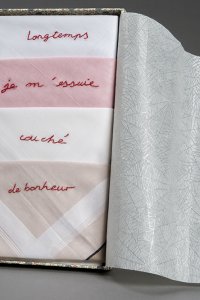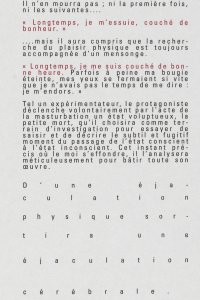Les mouchoirs de Proust
Year: 2014
Author: Nicole Morello 1953
Artist: Nicole Morello 1953
Handkerchiefs
The 120 handkerchiefs included in this edition come from all over the place, they were bought at a market or, for instance, received from friends. While doing such things as travelling somewhere by train or sitting in the garden Morello embroidered the words onto the handkerchiefs. Therefore they each have a different history (one that is unknown to the reader) but they each remind the artist of a different location in much the same way that the protagonist of Remembrance… recalls his youth and how he then experienced the world.
The handkerchiefs are packed in a box that is covered with Italian, florally decorated Varese paper. Hidden beneath that is a printed booklet, designed by Nora Gummert-Hauser (1959), set in Univers typeface and digitally printed at the Design Typografie und Editorial Design department at the Hochschule Niederrhein in Krefeld. Les mouchoirs de Proust is no ordinary reading object; the reader needs to use both hands to unpack the box and unravel the text.
A certain time, but what is the tense?
In the booklet, the simple yet mysterious opening sentence of Proust’s novel is explicated. The sentence alludes to a certain time, but what is the tense? The homophone variant thought up by Morello in the middle of the night, while lying in bed, parallels Proust who not only talks in the opening sentence of going to bed but who wrote the whole novel in bed. Morello found the many envelopes and handwritten cards in the novel rather notable because of the wrongly spelt or incorrectly explained words and the great divergence between what can be uttered and what can be understood.
The homophone sentence is about a room that Proust remembers, the only room that he was allowed to lock and where four solitary activities occurred involving: ‘la lecture, la rêverie, les larmes et la volopté’, in other words: reading, dreaming, crying and masturbating. The handkerchiefs have different functions.
Bibliographical description
Description: Les mouchoirs de Proust / Nicole Morello. - [Düsseldorf] : [Nicole Morello], 2014. - 4 zakdoeken, in rood geborduurd met teksten ; 27 cm
Printer: Design Typografie und Editorial Design, Hochschule Niederrhein (Krefeld)
Typeface: Schrift Univers
Edition: 30 numbered and signed copies
This copy: Nr. 03/30
Note: In a handkerchief box
Shelfmark: KW Koopm P 10039
References
- Paul van Capelleveen, 'Nicole Morello', in: Artists & others. The imaginative French book in the 21st century. Koopman Collection, National Library of the Netherlands. Nijmegen, Vantilt Publishers, 2016, p. 192-193.
- 'Morello' [website]


